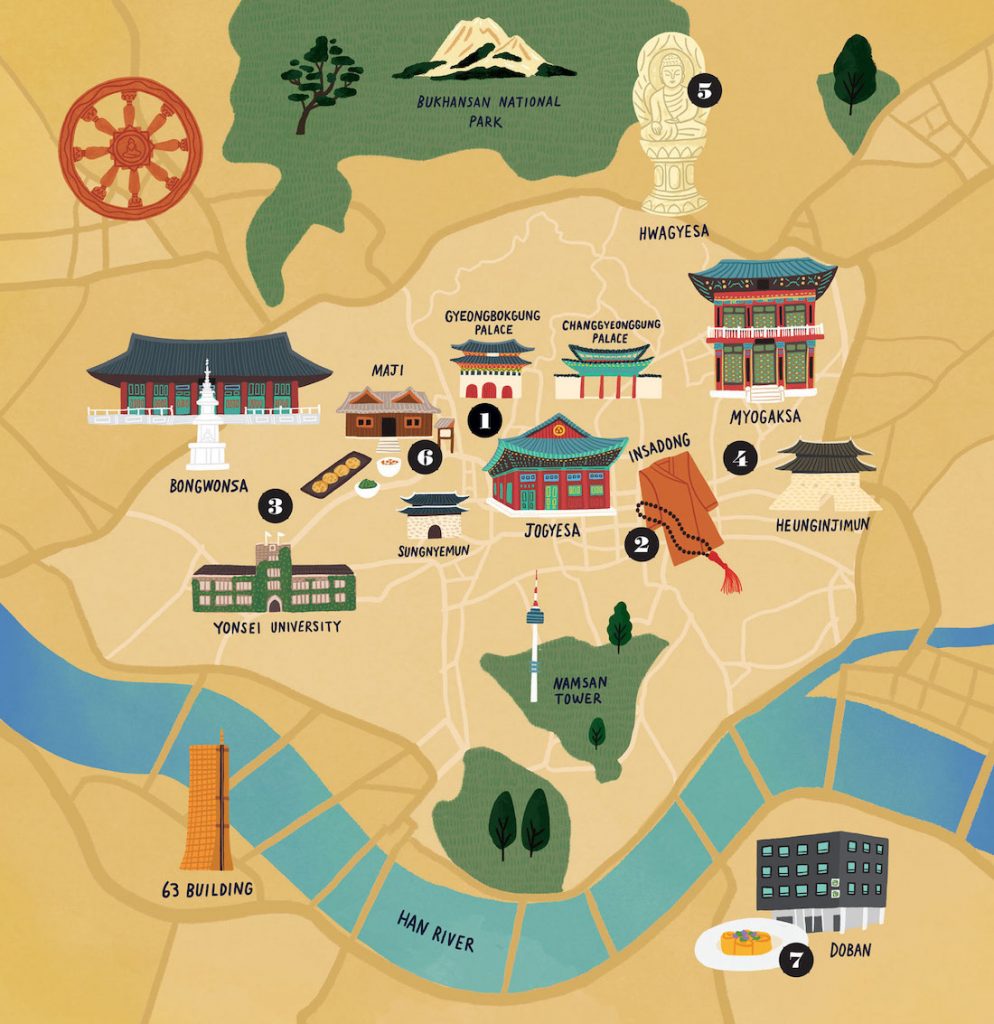Buddhist history and culture permeate Seoul, but you need to know where to look in this vast and bustling world-class city. Korean Buddhism dates back to the 4th century CE and exerted tremendous influence throughout East Asia. Politically sidelined and pushed out of the cities for 500 years during the Confucian Joseon dynasty (1392–1897), the most impressive temples are deep in the mountains and require travel and hiking to reach. Korea has spectacular temples, mountaintop hermitages, towering pagodas, ancient ruins, rock-hewn grottoes, and precious Buddhist relics too numerous to see in one trip. Most South Korean cities have Buddhist temples, and Seoul is no exception. Here are some favorite spots:
1| Jogyesa
Dating back to the 14th century, Jogyesa is the head temple of the Jogye Buddhist Order, the largest order in Korea. This temple lies in the heart of the historic district between Gyeongbokgung and Changgyeonggung. The sound of chanting monks and the smell of incense drift through the air around the main dharma hall. Another building enshrines a statue of Amitabha Buddha, and the two 500-year-old white pine trees on the grounds are designated Natural Monuments. The best time to visit is during the Buddha’s Birthday festivities in May, when copious colorful lanterns carrying the wishes and prayers of lay members are hung over the temple grounds.
55 Ujeongguk-ro, Jongno-gu
jogyesa.kr/eng
2| Ujeongguk Street and Insadong
Want some prayer beads or Buddhist robes? Maybe little plastic Buddhist tchotchkes or high-end Buddhist art to take home? Wander the neighborhoods around Ujeongguk Street in front of Jogyesa and peruse the numerous shops that cater to monks and nuns, art collectors, lay pilgrims, and tourists. These shops are visual wonderlands. Neighboring Insadong Street is a popular destination for traditional arts and crafts, with many shops and street vendors selling Buddhist objects. Don’t be afraid to head down the narrow alleys winding off the main thoroughfares, where you’ll find some of the best restaurants and shops.
Ujeongguk-ro, Jongno-gu Insadong-gil, Jongno-gu
3| Bongwonsa
Founded in 889 by Master Doseon, Bongwonsa, the head temple of the Taego Buddhist Order, sits at the foot of Ahn Mountain on the Yonsei University campus, tucked away in a quiet part of this dense and noisy metropolis. The temple ground comes with a sordid tale involving a serial killer and offers up a sacred space with a few ghosts wandering about. Make sure to check out the university campus and take a hike up Ahn Mountain for an unforgettable view.
San 1 Beonji, Bongwon-dong
bongwonsa.or.kr/eng/
4| Myogaksa
Myogaksa is the administrative headquarters of the Gwaneum Buddhist Order, situated in the heart of downtown Seoul. Founded in 1942 by Ven. Taeheo Hongseon, this temple occupies an important geomantic site on the east side of Mount Naksan and has a statue of Avalokiteshvara, the bodhisattva of compassion, carved into the hillside. Myogaksa has a temple-stay program for travelers and regularly conducts tea ceremonies. After emptying your mind in a meditation session, head over to the nearby Dongdaemun markets or the famous Dongmyo Flea Market to fill up your shopping bags.
31 Jong-ro 63ga-gil, Jongno-gu
myogaksa.net
5| Hwagyesa
Established in 1522 as a hermitage, this large temple complex in the Samgak Mountain foothills was an important Joseon dynasty royal temple where aristocratic female devotees would go to learn the dharma, practice, worship the Buddha, and get away from their restrictive Confucian confines. As the home temple for internationally famed Master Seungsahn (1927–2004), founder of the Kwan Um School of Zen in the United States, Hwagyesa is noted for its temple-stay program and resident Western renunciates. The surrounding scenery is breathtaking, and the sound of the dharma bell ringing through the hills on a misty morning is magical.
117 Hwagyesa Road, Gangbuk-gu
hwagyesa.org/
6| Maji Restaurant
Vegans beware! Many foods in Korea, even those labeled as vegetarian or vegan, are prepared with fish or shellfish oils or pastes (particularly the kimchi). If traveling through Korea, your best bet is a restaurant specializing in Buddhist temple food. Maji will not disappoint. Even a diehard meat eater won’t be able to deny this tantalizing nirvanic experience served in a serene traditional setting. The Buddha himself would hardly pass up this opportunity to eat like a bodhisattva.
19 Jahamun-ro 5-gil, Jongno-gu
happycow.net
7| Doban Restaurant
Run by a Buddhist nun, Doban is the real deal for authentic and organic temple food, but you’ll need a reservation (except during lunch, when you might get squeezed in). The basic lunch menu is simple and inexpensive. The more extravagant three-course meal options, which are pricey but worth every penny, require a reservation and an order placed in advance. I highly recommend the ten-dish three-course option (Course Reservation C), but you need a minimum party of three to obtain this dharma treasure. Don’t incur any bad karma—call ahead and dress appropriately.
7-27 Mabang-ro 6 gil, Yangjae-dong
Thank you for subscribing to Tricycle! As a nonprofit, we depend on readers like you to keep Buddhist teachings and practices widely available.
